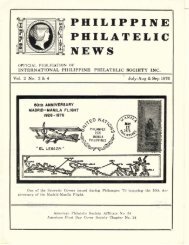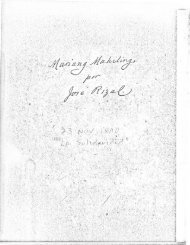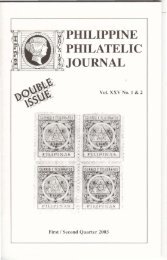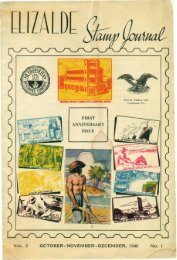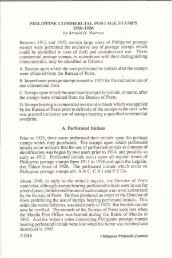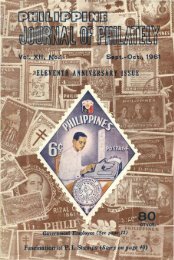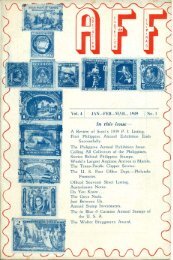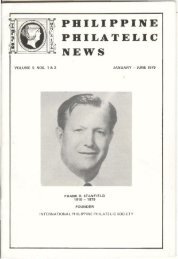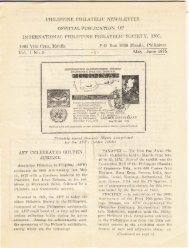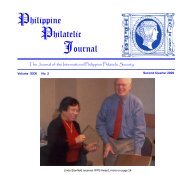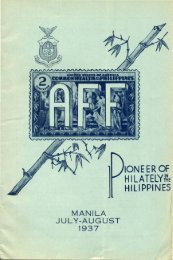Fourth Quarter 1997 - International Philippine Philatelic Society
Fourth Quarter 1997 - International Philippine Philatelic Society
Fourth Quarter 1997 - International Philippine Philatelic Society
Create successful ePaper yourself
Turn your PDF publications into a flip-book with our unique Google optimized e-Paper software.
7. Nunez, Nestor c., <strong>Philippine</strong>-American War: "IslandHopping" <br />
ofa u.s. Military Cancel: Additional Notes, unpublished manuscript<br />
which makes additional comments on the use of the OS1<br />
device which was the subject ofan article by Haberland, Wolfgang,<br />
American <strong>Philippine</strong> War 1899-1902, Island Hopping by a US<br />
FieldPostCancel(translated by c.A. Richmond from "Rundbrief<br />
USA"), Possessions, published by the United States Possessions<br />
<strong>Society</strong>, Vol. 17 No.1, Whole 59, First <strong>Quarter</strong> 1994. It is curious<br />
that Goodale did not include this datestamp among his list of<br />
postmarks (see Endnote 8). The Nuiiezcollection has a cover from<br />
Goodalesentto Laredo, Texas with US1 and OS1 dated March 17,<br />
1899. The Kugel collection also has these combination uses in a<br />
postcard to Zurich postmarked March 20, and as receiving marks,<br />
dated March 17, 1899.<br />
8. The Hoge photocopy archive has a U.S. One Cent Grant postal<br />
card with paid reply, which was sent from Grass Valley, CA on<br />
February 23, 1899 to Goodale (addressed to Manila). The card<br />
was evidently forwarded to Cebu (where Goodale was stationed<br />
from March 1) and postmarked on receipt on April 10 (OS1 and<br />
USl strikes). This is most likely the "cover" that Goodale referred<br />
10, and he mistakenly supposed that the OS1 strike was a Manila<br />
receiving mark.<br />
9. Correspondence from Capt. Weston O. Burnell, August 27,<strong>1997</strong>.<br />
10. Baker, Philip E., Postal Markings of United States Military<br />
Stations, 1898-1902, 1963.<br />
CEBU BISECTED STAMPS<br />
By Col. Gustavo C. Ingles<br />
Bisected stamps are stamps which are cut into halves to allow usage<br />
of part, normally fifty (50) percent, of its face value. (COVER) This<br />
mode of payment for postal charges is authorized in some countries<br />
in case of shortage of stamps of the required denomination. Its<br />
employment has never been authorized by the Postmaster General of<br />
the <strong>Philippine</strong>s. There was an instance, however, when it was employed<br />
in Cebu City in the <strong>Philippine</strong>s after 1945 due to extreme<br />
shortage of stamps of the required denomination.<br />
Cebu City was the second largest city in the <strong>Philippine</strong>s after World<br />
War II. It was forced to use bisected stamps early in 1948 due to the<br />
absence of the necessary two-centavo stamps for its domestic mail<br />
service.<br />
<strong>Philippine</strong> Philnlelic Journal 9




